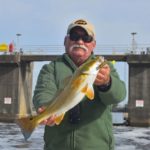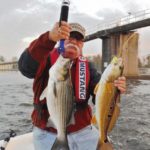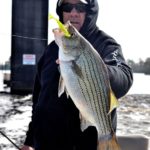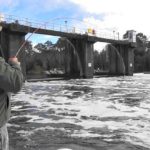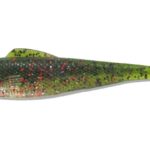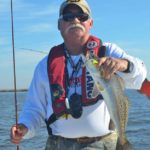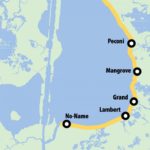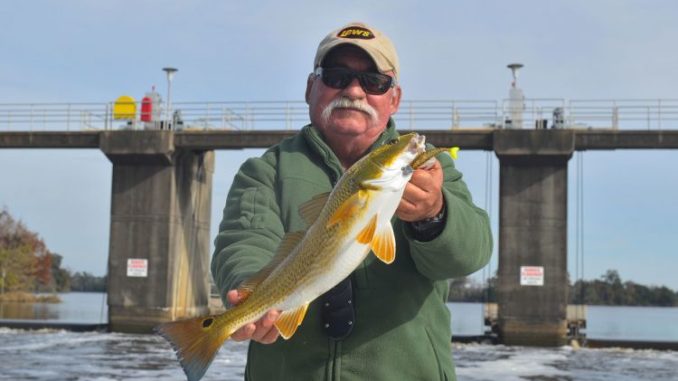
In the winter, Big Lake’s estuary can get pretty frigid — and many anglers head for their deer stands and duck blinds. But those in the know hit these spots for wintertime battles with redfish, hybrid stripers and speckled trout.
On a chilly 39-degree December morning, Big Lake’s Ray Christy had a smile on his face when he launched from the public landing at Riverside Park in Westlake.
“They’re stacked in there,” the 70-year-old angler said. “I left the fish biting yesterday.”
Christy was referring to redfish and hybrid stripers stacked up adjacent to the Calcasieu River Saltwater Barrier, located just a little north of the landing.
The barrier, located just south of Westlake, was authorized by Congress in 1962 and was designed to block saltwater intrusion into the Calcasieu River.
Christy is a Vietnam War veteran and retired helicopter pilot. But even during winter’s coldest months, he will spend at least a couple of days a week fishing the Calcasieu Lake estuary.
He was well-prepared for the trip, bundled up and wearing layers, knowing that both the boat ride and the fishing would face the north and northeast — and cold winds were howling.
At the saltwater barrier, water was gushing over the weirs from the north, ending up in stained, sudsy rapids rushing south to the old river channel.
Putting the trolling motor down 30 yards away from the structure, Christy began a series of casts with an opening-night Egret Baits’ 3 ½-inch Wedgetail Mullet attached to a half-ounce jighead.
The angler’s lure would drop on the eddy side of the columns supporting the barrier, and he would work the Wedgetail by swimming it slowly once it reached depths of 20 feet or more.
It didn’t take long for Christy to begin battling both redfish and stripers.
“These fish fight a bit hard because of the current here,” he said. “As they head south taking drag, the current is moving with them.”
The first few fish Christy landed were slot redfish ranging to 22 inches.
Fat hybrid stripers
Following the battle with the reds, Christy hooked another fish that had a different attitude.
“This has to be one of those hybrid stripers,” he said. “Notice how the fish runs north against the current and toward the structure.
“These hybrids will run wide and keep their noses into the current. They’ll bury down hard and make for a tougher fight.”
For another hour, Christy fought both redfish and stripers on about every other cast. His rod arched several times as the drag on his spinning reel hummed.
“It’s every winter here like this when the waters are cold,” he said. “There’s a lot of shad pouring over the structure from the northern Calcasieu River, and these fish are eating well.”
According to biologist manager Sean Kinney with the Louisiana Department of Wildlife and Fisheries in Lake Charles, the hybrid stripers found in the area have been stocked periodically in the Calcasieu Lake estuary. The fish are a sterile cross between white bass and striped bass, and are produced in hatcheries for recreational value — and as an aid to control baitfish populations.
The best part of the trip was that Christy’s boat was the only one at the structures.
“It’s waterfowl and deer seasons here,” he said. “Many people prefer a duck blind or heated deer stand than to stay here and brave the cold and moist temperatures.”
Christy’s structural strategies
Christy has learned to be very methodical in his approach to fishing the barrier.
“The tides must be right,” he said. “When there is a 6-inch drop with water pouring over the weirs heading south, the saltwater side is the place to be.”
The angler will tightline chartreuse-pepper, gold-nugget and opening-night 3 ½-inch Wedgetail Mullets, as well as lime-glow 5-inch versions.
“I will swim the Wedgetails slowly and twitch them every now and then,” he said. “The idea is to keep these baits moving as the motion allows the tails to vibrate and encourages the fish to bite.”
Another swimbait Christy will use is Egret’s 1-ounce, 5 ½-inch VuDu Mullet.
“This bait is heavy enough to get down real deep,” Christy said. “Its action effectively mimics the shad swimming in schools near the barrier.”
He casts the lures with both baitcast and spinning equipment, mainly Lew’s rods and reels. He uses medium-heavy action 6-foot, 10-inch rods when casting for redfish, and medium 6-foot, 8-inch ones when targeting speckled trout. His reels are spooled with 30-pound braid and a 15-pound fluorocarbon leader.
Occasionally, Christy scores on hefty specks that sometimes school with the redfish near the structure.
“I have taken speckled trout weighing 6 and 7 pounds here,” he said. “But that doesn’t occur too often, and the salinities have to be high at the Saltwater Barrier for the trout to move in.”
At the structure, Christy typically begins by using a ¼-ounce jighead to sweep the weir walls.
“I’ll make eight to 10 casts and then move to find where the fish are,” he said. “If I am not successful fishing directly on the structure, I will back off 100 yards and start the process over again.
“I’ll use heavier jigheads — up to an ounce — until I start catching fish or until I get hung up on the rocks and structures. Sometimes the fish will be behind the gates and along the concrete pillars in the eddies.”
Easy access to the south (saltwater) side of the Saltwater Barrier is via a small public landing, Riverside Park, located in Westlake at 1700 Miller Avenue.
Access to the north (freshwater side) can be gained directly on the side of the barrier itself at the U.S. Army Corps of Engineers public landing at the end of Mims Road.
Anglers with small boats or kayaks are warned that the current and rapids can be treacherous at times. All boats need a strong trolling motor to stay on the fish — and not damage hulls and motors on the structure.
Lake Charles
Christy often makes the run from Riverside Park Landing to Lake Charles just south of I-10.
“There’s a deep hole in front of the Civic Center that will concentrate speckled trout and redfish,” Christy said. “I’ll fish the area thoroughly with Wedgetails.”
Lake Charles is a cold-water hotspot in the winter when runoff from the Calcasieu River isn’t too extreme.
When water temperatures get into the 50s, speckled trout, redfish and the baitfish they are following will often seek the warmer thermoclines the depths can provide.
“I’ll fish Egret Baits’ Wedgetail Mullets on the dropoffs and ledges,” he said. “You want to take note of the depth on your sonar when you start catching fish.”
Regarding size, the redfish and speckled trout found in Lake Charles in December have been pretty respectable.
“The redfish quality is still there,” Christy said. “But the speckled trout here have tended to run just above keeper size in the past couple of years.
“In the past, specks would range here upward to 3 pounds on any given day, with an occasional trophy weighing 7 pounds or better taken up north near I-10. But that has not been the experience lately.”
Anglers who want to launch directly into Lake Charles will find a Calcasieu Parish boat launch right under the I-10 bridge approach on the east side of the Calcasieu River. You can access this landing by exiting on the North Lakeshore Drive exits (I-10 Service Road) off I-10.
Prien Lake
Prien Lake south of Lake Charles and just north of the I-210 span can also be a powerhouse spot in delivering numerous speckled trout during December.
It’s well-protected from the northerly winds that can sometimes push through during the winter months.
When waters are cold, there is a very specific way to find numbers of specks there, according to Christy.
“In December when water temperatures get cold, you’ll find speckled trout along the channel north of the I-210 span in 18 to 22 feet of water,” he said.
Prien Lake Park is the closest access point, and is located just south of the I-210 span.
“I’ll move to under the I-210 bridge and find the 18- to 22-foot dropoff and follow that ledge,” he said.
Christy’s arsenal of lures for the deep bite are plastics, such as Egret Baits’ opening-night, chartreuse-pepper and green chili-pepper 3 ½-inch Wedgetail Mullets – all cast on ¼-ounce jigheads.
The Southeast weirs
Peconi, Mangrove, Grand, Lambert and No-Name . . . .
These are the weirs that run along the eastern and southern banks of Calcasieu Lake south of Hebert’s Landing in Big Lake.
Access to the marsh on the other side of the weirs is prohibited during waterfowl seasons, but fishing for redfish on the lake side can be rewarding when conditions are right.
In fact, the fishing can get so good boats will often line up to get near the action on weekends.
Anglers are warned, however, there are signs indicating the distance you must remain from fishing near the weirs — the most productive of which are Grand Bayou and Lambert’s.
If anglers fish within that posted prohibited distance, they can be ticketed and will receive a hefty fine.
“An outgoing tide is necessary for the redfish to stack up near the weirs,” Christy said. “Baitfish will be pulled out of the marsh through the weirs, and the redfish will be waiting to forage on what comes through.”
The angler recommends fishing the weirs on weekdays as opposed to weekends, as there is a lot less pressure in that section of the lake.
Christy will cast 3 ½-inch Wedgetails (chartreuse-pepper, opening-night and gold-nugget) on ¼- and ⅜-ounce jigheads. The heavier jigheads are used when the current is strong coming out of the weirs.
Christy casts in the direction of the weirs and lets his baits fall, and then slowly swims them back to the boat. Schools of redfish will often be out away from the weirs if there is strong moving water.
Hebert’s Landing in Big Lake is the most popular access location, and the weirs are located on the southeastern banks due south.
